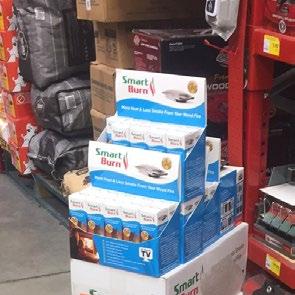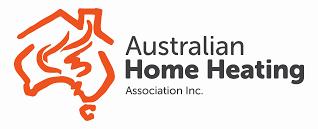
4 minute read
The technology of wood heating
The Principles of wood combustion
Wood is a complex fuel. It goes through three main phases when it burns. The first phase is drying, when any moisture left in the wood is evaporated. This absorbs energy. Once dry, the increasing temperature causes the wood to undergo chemical change and gas is released from the wood. This is the time when
Advertisement
the highest concentration of smoke is produced.
If there is a vigorous flame in the wood heater, then this stage of combustion is shortened and most of the smoke is burnt up before it gets to the flue. The second phase of combustion is the main flame burning stage. Burning kindling, or other burning wood, ignites the gases coming off the new wood. The gases burn to give the bright flame we see when wood is burning. The fastest release of gas occurs during the first 20 minutes or so after refuelling a hot heater.
It is essential to have plenty of air to mix with
the gas to make sure it burns. This is why it is so important to keep the air control fully open for the first 15 - 20 minutes. Once the wood is well alight, with some burning embers on the wood surface, the chances of the flame disappearing are slight, even when the air is reduced. The main flame combustion phase, which lasts for one to two hours in a typical heater, releases about half the energy in the wood. The third phase of wood burning is the charcoal stage. Once most of the gas has been released from the wood, a residue of almost pure carbon remains. This burns with very little release of smoke. This is when the air supply can be reduced without producing smoke particles.
Source: Professor John Todd who has been involved with heater research for more than 30 years
Get the most value from your wood
We encourage wood heater owners to take responsibility of their wood heaters to minimise smoke pollution in the neighbourhood and save money on running costs.
It is important to remember that smoke is actually wasted fuel that could otherwise have been converted to heat if the wood had burned more efficiently. Individually, wood heater owners can do a huge amount to reduce the pollution they emit and save money too.
You can minimise the amount of smoke from a wood heater if you;
• Burn only dry, seasoned, untreated wood • Establish a good fire quickly with plenty of kindling
Wood Pellet Heaters
• Use smaller logs to get the fire established and larger logs for slower burning • Stack log ends front to back, not side to side for better air flow • Do not overfill the heater • Keep the air controls fully open for the first 20 minutes of operation and again after adding wood • Add a SmartBurn to increase the woods performance by 17% Tip • and reduce particle emissions by up to 54% Maintain your heater and flue You can still use a SmartBurn within a pellet heater, as long as you find a place to support it flat and level within your burn chamber.
Incredibly popular in other parts of the world particularly Europe and North America the uptake of wood pellet heaters in Australia has been minimal relative to the approx. 40,000 new solid wood burning heaters sold annually across Australia. Pellet heaters are appealing for convenience, simplicity and environmental gains, however the availability of an economic pellet supply is often cited as a barrier. Australians overwhelmingly favour their traditional solid wood burning heaters.
New Technology - “Load and Leave”
New technology seen globally entering the solid wood burning heater market are automatically controlled wood heaters that offer the customers the luxury of being able to load and leave. This new tech has sensors that automatically adjust airflow into the firebox to maximise burning efficiency and minimise smoke. Without this automation, the airflow ought to be adjusted back to high for 20 minutes after each re-load of wood.
SmartBurn is a proud finalist and winner of 72 Awards

Importance of a good flue
How does a chimney or flue work?
Think of the chimney as the engine that drives the heater. The more fuel (heat) you give the engine (chimney flue), the more power (draft) it will deliver. And draft is good!
When you build a fire in a heater where the chimney flue is installed correctly, the kindling ignites easily, draft increases rapidly and you should have a nice bright, hot fire quickly.
What effects draft?
The hotter the gases are inside your chimney compared to the outside temperature, the stronger the draft will be.
The height of your chimney and draft are related; a taller chimney will create a stronger draft.
Installation
The flue must be of the correct size, design and type for the appliance and your roof. requirements for total height, height above the roof peak, and clearances for the penetration of the ceiling and roof.
Maintenance
We recommend the services of a chimney professional to inspect your flue, not only for cleaning, but for structural and corrosion issues on an annual basis.
Thinking of buying a new wood heater?
Be sure to check out the information available at www.homeheat.com.au for a list of all of the Certified Wood Heater models that are approved for sale in Australia. You can also compare efficiency and smoke output between models. This comprehensive resource site is provided by the Australian Home Heating Association of which SmartBurn are members and supporters.











